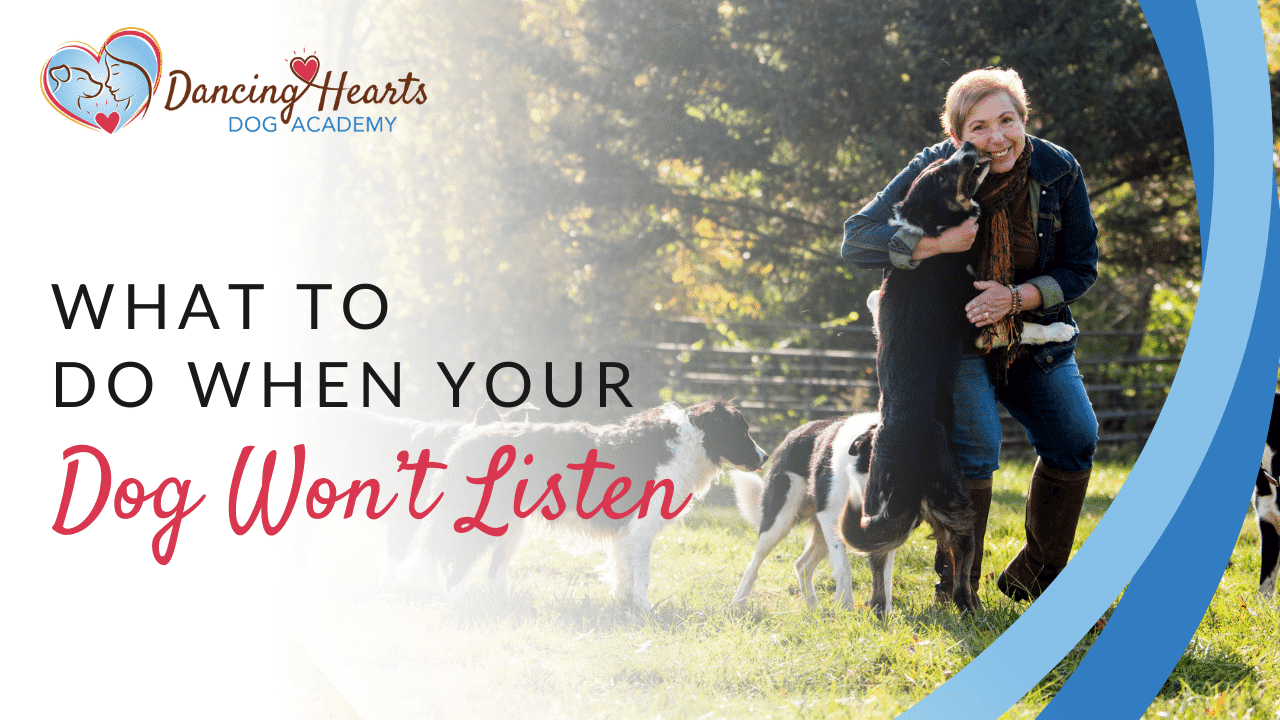What should you do when your dog won’t listen?
You tell them to come to you, they run in the opposite direction. You ask them to stop barking, and they bark louder. You ask them to get off the couch, and they snuggle into it some more. You get the idea.
Sometimes, it feels like our dogs are rebellious on purpose. They flat out refuse to listen, and you’re left wondering if they go out of their way to make your life harder. When your dog refuses to listen to you, what should you do about it?
In this post, I’m sharing some golden nuggets from a coaching call I did with members of my Brilliant Partners Academy. It was such a great lesson on what you can do when your dog gives you a hard time.
Dealing with a dog who has changed their behavior
I began the coaching session with a Q&A with a member of BPA, Christina. Here is the overview of her problems with her dog Dubey and her question:
“We’re almost two months in with BPA, and it’s been an eye-opening journey. So very different from any other program I’ve been involved with. As partners, I’ve learned that we don’t pull and dictate another’s actions with commands. This had me in a bit of a pickle with my pup Dubey this week, he’s been exhibiting very rebellious behavior in an escalating fashion over the last ten days.
“By rebellious, I mean he’s climbing on the sofa without an invitation, jumping on the bed refusing to get off, ignoring our wait at doors, and developing a serious noise and window barking reaction that has never been a problem before. The window reaction, I’ve tried to roll back by explaining what’s going on outside, closing the blinds, giving him something to do, and getting up and leaving the room while talking with my senior pup.”
Christina then went on to talk about what she has been doing to try and reverse this type of behavior. She explained that privileges, such as lying on the sofa, are allowed by invitation only. She has told him to get off the bed, but he looks at her with big puppy eyes and lies back down.
“I don’t want the situation to reach a point where I need to hold his collar and guide him onto the floor. But it is the only way to get them off. I know that I must be doing something wrong, but I’m not sure what I need to do to stop this rebellious exchange… how do I get Dubey off the bed without pulling him or get back to grazing when he reacts to something that has not previously triggered him. I feel like we’ve moved backwards since our walking dance sessions.”
Have you experienced some of the same things as Christina?
If so, keep reading to find out what pieces of advice I shared with her to help overcome these issues.
Change your perspective
If you’re experiencing similar issues with your dog, the first thing I recommend is a change in perspective. When your dog acts out, it’s easy to label them as rebellious, especially when your dog is suddenly exhibiting a behavioral change. If your dog hasn’t acted out in this way before, it must be because he is rebellious.
However, dogs are not rebellious on purpose. Instead of thinking that your dog is giving you a hard time, reframe it to your dog is having a hard time.
Understand that behavior is communication
When your dog is having a hard time, it allows you to put what you’ve learned into action. If you are a BPA member, you will know the principles of living a safe, calm, and happy life with your dog. You’ll also learn how important it is to be your dog’s role model when they’re having a hard time.
So, think about how you can be proactive instead of reactive. How can you get back to seeing your dog as perfect?
Dogs use behavior to communicate. To us, it might look like they are acting out when they leap up on the couch despite our disapproval. In reality, they are communicating to you that they don’t know what is expected of them.
What to do if your dog doesn’t like the leash
Christina talked about how her dog’s recent change in behavior only came about after she began doing the walking dance with him. The walking dance is something that I teach inside the Brilliant Partners Academy that helps dog moms and their dogs learn to walk together without any pulling or lunging, etc. Dubey hates the leash on a good day, so you can imagine how unhappy he was when Christina put the leash on him!
Being in the default position during the walking dance is a critical step in the process. The default position is your position relative to your dog. It is your responsibility to put yourself in that position, not your dogs.
Not all dogs can walk off-leash safely. Some dogs will run off and never come back or get themselves in trouble. Whenever I hear people tell me that their dog doesn’t like the leash, I always tell them the same thing. Your dog doesn’t care about the leash. It’s not your dog that doesn’t like the leash, it’s you who doesn’t like the leash.
Yes, your dog probably doesn’t want to walk on a leash. But the leash experience is what you make it. Walking on the leash is a learned skill that requires a high level of impulse control from both you and your dog.
So, take it slowly. Your dog is not going to learn to walk correctly on the leash with one training session. It takes time to build those skills. Put yourself in the default position as much as possible while your dog is off the leash. You can do this when you’re getting ready play, leaving the house, walking towards a door, and so on.
Tips for leash walking
Many great experiences happen when you and your dog are side by side. So, get into the default position next to your dog and take five steps together. You can take five steps to the fence in your back yard or five steps to the kitchen counter. It’s up to you. Taking it slow helps your dog to grow accustomed to walking on the leash. It’s much easier to walk your dog on the leash in familiar places like around your house and the back yard than it is to walk them on leash somewhere different.
You can hook the leash to your belt or tie it around your waist if it’s long enough. That way, you and your dog can walk side by side, helping your dog get comfortable with the leash. After some time, the leash becomes a safety net, which is what it should be. It gives you peace of mind knowing that your dog can’t run into the road or run off somewhere during the walk.
Your primary focus should be to walk together as partners. You need to make sure that you are present to help your dog move through difficult times. If you let yourself get distracted while you’re walking with your dog in a busy park, you might miss cues from your dog that could’ve prevented an “incident” from taking place.
Unravel your dog’s behavior
If your dog’s behavior suddenly changes, it can be confusing trying to figure out why. However, the more we choose to be confused, the more confusing things get. Understanding why your dog’s behavior has changed is about really listening to what they are trying to communicate.
Think about whether your dog feels heard. Are their basic needs being met? Or, are you pushing their feelings aside and letting your dog know that their feelings are not justified? That could be stressful for your dog, who deserves to be heard and loved.
Remember that your dog is not rebellious on purpose. Your dog is trying to communicate something, and it’s up to you as your dog’s partner to figure out what that is so that you can help them overcome the problem.
Watch a trailer of the episode below:
If you’d like to work with me and learn how to create a partnership lifestyle for you and your dog, you can request an invitation to join us in the Brilliant Partners Academy when the doors open for the next enrolment!
You can listen to everything I talked about in this blog post over on my podcast – Enlightened By Dogs. It’s episode 130, which you can listen to here.






